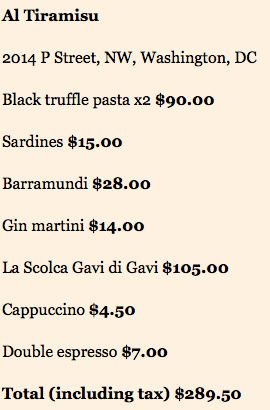The Globe and Mail‘s Doug Saunders writes this on Twitter:
What Charles Murray had for lunch while telling the FT that the working class had become culturally irresponsible
The FT‘s Edward Luce did the lunch interview:
Our black truffle has arrived. Murray’s martini glass is empty. The waiter pours him a taster from the bottle of Gavi di Gavi, an Italian white wine. “Mmmm, it’s like a good Montrachet,” Murray says. “I think it’s an excellent choice.” Every minute or so for the next few, Murray declares how excellent the pasta is. “Oh, this is lovely,” he observes mid-mastication. “Yes, really delicious.” I ask him what kind of wine a Gavi di Gavi is. Murray discloses that it is a “varietal”. I nod as though I know what that means. It certainly tastes nice. “Varietal means expensive,” he adds. I take a full glass.
Meantime, hedge-fund impresario Ken Griffin talks to the Chicago Tribune about the political influence of billionaires like himself:
I think they actually have an insufficient influence.
Griffin then goes on to compare Obama policies (implicitly) to those of the Soviet Union and Communist China, and says he should be able to give unlimited amounts of money to influence elections.
No wonder he rarely gives interviews.
— Gretchen Morgenson has a very interesting column on taxes at Fairfax Financial, which is embroiled in bitter litigation with hedge funds, one of whom complained about the company to the IRS.
Fairfax got $400 million in tax breaks from 2003 to 2006 for a complex deal it made with Odyssey RE and Bank of America. Long story short, whether Fairfax qualifies for the tax break hinges on whether it actually owned $78 million worth of shares it borrowed from Bank of America or whether that transaction was a “sham.” Unfortunately for Fairfax:
One of the more interesting documents in the public domain, though, is an internal April 2003 e-mail from Robert Giammarco, then a Bank of America executive who managed the bank’s relationship with Fairfax. The e-mail outlined the pros and cons of the deal; one disadvantage, the e-mail warned, was that the deal “Does not provide true economic ownership of the ORH shares to Fairfax.” Marketing materials used by Bank of America to pitch a similar deal to another insurer, the St. Paul Companies, noted the same problem. (St. Paul did not do the deal.)
Fairfax said that Mr. Giammarco was mistaken and that he subsequently changed his mind. Its lawyers produced several pages of a 2011 deposition in which he backed away from his initial view on the ownership issue. “I think I just got it wrong,” he said.
Notable, however, is the fact that Mr. Giammarco’s shifting perspective came after he had worked at Odyssey from March 2005 to October 2006 as executive vice president and, for much of that time, as chief financial officer. When he left Odyssey, he got $2 million in severance and other pay. He is now a Merrill Lynch banker.
— The Washington Post has a good piece on how the newspaper industry invented the iPad (or conceptualized it, anyway) more than fifteen years before Apple did and then didn’t patent it.
While McClatchy (Knight-Ridder’s owner now) surely rues this decision, Roger Fidler, who dreamed up the tablet, says he doesn’t:
Knight-Ridder lawyers visited the lab in 1993 and discussed whether they should patent Fidler’s tablet design. But design patents are difficult to protect. Also, Fidler argued the best way to build tablets was to not stifle development by cornering the market on the idea with patents. The technology industry eventually went the other direction, with companies seizing patents as innovation land grabs.
But Fidler’s idea may end up defeating a patent suit by Apple against Samsung:
Apple is using this design patent — in legal papers it is known as D889 — to argue in federal court that Samsung copied the iPad with its competing Galaxy Tab 10.1 tablet, released in 2011. The Cupertino, Calif.-based company even took the extraordinary step of asking a judge to halt sales of the Galaxy Tab before trial. “The overall appearance of the Galaxy Tab 10.1 is strikingly similar to the D889 patent,” Apple lawyers argued in legal briefs, “and shows Samsung’s copying. Every major element of Apple’s patented design is found in the Galaxy Tab 10.1.”
But Samsung’s lawyers countered that Fidler’s video put the design into the public domain in 1994, well before Apple filed its patent. (They mentioned his 1981 essay, too.) Samsung’s lawyers also noted that when Apple filed its patent, the company made no mention of Fidler’s device even though the company, which had its lab next to Fidler’s, knew of it because it had worked with him and his lab. The U.S. District judge in the case, Lucy H. Koh, declined Apple’s request to halt sales of the Galaxy Tab, in part because she found Samsung’s argument about Fidler’s tablet convincing.
Fidler will testify against Apple as a paid witness.
If you’ve never seen that 1994 Knight-Ridder video introducing the tablet computer and what it would mean for news, watch it:
And while you’re at it, read Michael Shapiro on “The Newspaper That Almost Seized the Future,” from CJR‘s November/December issue.
Ryan Chittum is a former Wall Street Journal reporter, and deputy editor of The Audit, CJR’s business section. If you see notable business journalism, give him a heads-up at rc2538@columbia.edu. Follow him on Twitter at @ryanchittum.

